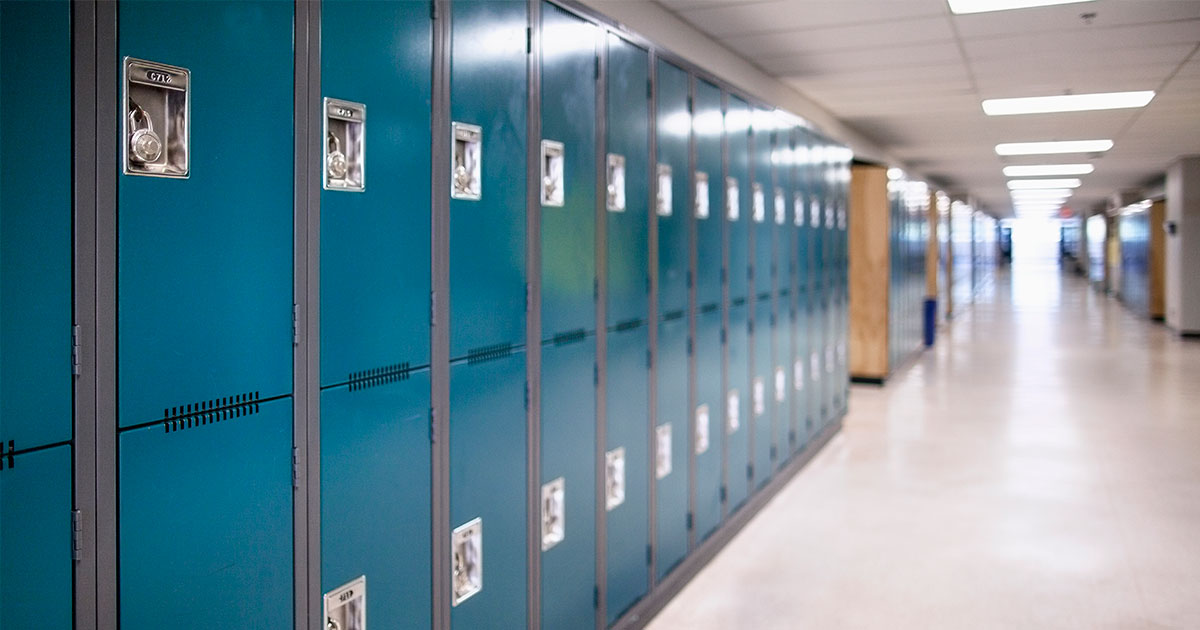
Aug. 17, 2022 – When the school year begins next month, Wisconsin school administrators will take up the task of managing student anxiety in the wake of the Uvalde school shooting. Two federal court decisions on cases from Wisconsin instruct that administrators face a balancing act related to First Amendment expression.
Gun Shirts Lead to Discipline
The first decision,
Schoenecker v. Koopman, 349 F.Supp.3d 745 (E.D. Wis. 2018), came in a case that began when a freshman at Markesan High School wore two t-shirts that depicted firearms and other weapons.
 Jeff M. Brown is a legal writer for the State Bar of Wisconsin, Madison. He can be reached by email or by phone at (608) 250-6126.
Jeff M. Brown is a legal writer for the State Bar of Wisconsin, Madison. He can be reached by email or by phone at (608) 250-6126.
One shirt depicted a dozen different guns, including semi-automatic long guns designed for military use, above the words “Celebrate Diversity.”
The other shirt depicted a handgun, a hand grenade, two knives, and a semi-automatic military weapon arranged so that they spelled the word “LOVE.”
When the student wore the shirts to school, several teachers felt uncomfortable and sent the student to the principal’s office.
The principal told the student that the shirts violated the school’s dress code because they depicted weapons. Although the dress code did not prohibit shirts that depicted weapons, the principal claimed the dress code granted him discretion in interpreting it.
The principal met with the student’s parents and told them the student was not allowed to wear clothing that depicted weapons.
When the student continued to wear the shirts to school, teachers made him cover the shirts or turn them inside out. When the student refused to comply, the teachers sent him to a small office in the school where students are segregated and receive no instruction.
The student sued the school district under
42 U.S.C. section 1983, seeking a declaration that the school’s actions violated his First Amendment right to free expression.
He also asked the court to order the school to allow him to continue wearing the two shirts, and later filed a motion for a preliminary injunction barring the school district from disciplining him for wearing the shirts.
The student then wore a third gun-related shirt to school. That shirt depicted no weapons but contained the following words: “IF GUNS KILL PEOPLE, I GUESS PENCILS misspell words CARS drive drunk & SPOONS make people fat.”
Shirts Were Protected Expression
In his decision granting the plaintiff’s motion for a preliminary injunction, District Judge Lynn Adelman concluded that each of the shirts contained expression protected by the First Amendment.
The third shirt, Adelman explained, used analogy to make the point that a gun is an inanimate object that can only kill when used by a person.
“This is a common argument made by those who oppose gun control, and any person who saw the shirt would readily understand it to mean that the plaintiff opposed laws restricting private ownership of firearms,” Judge Adelman wrote. “Thus, when he wears the shirt, the plaintiff expresses his personal belief on a matter of public concern.”
The school district argued that the other two shirts did not constitute protected expression because they didn’t convey specific, unambiguous messages.
In support of that argument, the school district cited federal case law involving expressive conduct – burning the U.S. flag and a women going topless in public. Under those cases, conduct is entitled to First Amendment protection only if it is “inherently expressive” and communicates its message comprehensively without additional speech.
Judge Adelman reasoned that the student’s t-shirts were different from flag-burning or baring one’s breasts in public.
“Wearing the shirts is conduct, but the shirts themselves are pure speech, in that they contain images and words that convey a message,” Adelman wrote. “The message may be ambiguous and open to interpretation … but this does not deprive it of First Amendment protection.”
What’s too remote? We’re still talking about Columbine.
Tinker Standard
Judge Adelman then applied the analysis laid down by the U.S. Supreme Court in
Tinker v. Des Moines Independent Community School District, 393 U.S. 503 (1969).
In that case, the Supreme Court held that a high school may restrict student speech only if the speech “would materially and substantially disrupt the work and discipline of the school.”
The Markesan School District argued that the t-shirts met the
Tinker standard because school district employees told the principal that the shirts made them worried about school safety. The student wore the shirts to school shortly after the school shooting in Parkland, Fla.
The principal pointed out that the Parkland shooting inspired a student walkout at Markesan High School. He also testified that the plaintiff’s t-shirts sparked student discussion and arguments that disrupted classes on multiple occasions.
Judge Adelman concluded that the school district had not shown that the t-shirts had materially and substantially disrupted the work and discipline of the school.
He pointed out that there was no evidence that any student felt threatened by the t-shirts. Judge Adelman also noted that there was no evidence that the t-shirts affected any teacher’s ability to provide instruction.
As far as the disruption caused by student discussion and argument, Adelman wrote that the principal hadn’t provided enough detail about the disruption, “so it is hard to infer that the disruption was substantial or that it would be reasonable for the defendant to forecast that additional such disruptions will occur if the plaintiff is allowed to continue wearing the shirts.”

Sara C. Mills, a litigator at Crivello Carlson S.C., represented the school district in the
Schoenecker case. Mills said she wished the court in
Sonnabend had been clearer about the weight a court should give recent events when applying the
Tinker standard.
‘Recent Events Might be Relevant’
In the time since Judge Adelman handed down his decision in the
Schoenecker case, more than 100 school shootings have occurred – including one at Robb Elementary School in Uvalde, Texas this year in which an 18-year-old man killed 19 students and two teachers.
What effect might heightened fears about school shootings have on the
Tinker calculus as applied to a school’s efforts on regulating gun-related expression? A recent decision by the U.S. Court of Appeals for the Seventh Circuit offers some clues.
In
Lloyd v. Sonnabend, No. 21-1959 (June 15, 2022), a three-judge panel ruled that the
Tinker analysis applied to student challenges to dress codes in two Wisconsin school districts that prohibited wearing t-shirts depicting pistols.
One of the t-shirts read “Smith & Wesson Firearms Made in the USA Since 1857;” the other read “Wisconsin Carry, Inc.”
In an opinion written by Chief Judge Diane Sykes, the court pointed out that under Seventh Circuit case law, a school district wasn’t required to prove that serious consequences would in fact result from the failure to forbid the speech at issue.
But more than speculation was required, Sykes wrote, and “there’s no ‘generalized’ “hurt feelings” defense to a high school’s violation of the First Amendment rights of its students.”
Sykes noted that the
Tinker standard acknowledges that school officials have broad authority to keep order and discipline to aid learning. In addition to the age and grade level of the students to whom the speech at issue is directed and the history of the school, Sykes wrote, “[t]emporal factors and recent events might be relevant.”
‘What’s Too Remote?’
Two Wisconsin lawyers spoke to
InsideTrack™ in an effort to understand how that wording from the
Sonnabend decision might affect a court’s
Tinker analysis in the wake of the Uvalde horror and the string of recent school shootings.
Sara C. Mills, a litigator at Crivello Carlson S.C., represented the school district in the
Schoenecker case. Mills said she wished the court in
Sonnabend had been clearer about the weight a court should give recent events when applying the
Tinker standard.
“Because you say it might be relevant that means it might not be relevant, and I think that is very divorced from the reality that kids have going to school every day,” said Mills, the parent of two grade-school children. “It’s relevant to them every day.”
Mills wondered how proximate in time and location must a school shooting be to count as relevant to the
Tinker analysis.
“What’s too remote?” Mills said. “We’re still talking about Columbine.”
Mills also said that the court in
Sonnabend missed an opportunity to clarify how the
Tinker standard – created in a world with no internet and social media and far fewer school shootings – should apply to schools’ efforts to regulate potentially disruptive gun-related expression.
“I know it’s an objective test, but a lot of how people react and how it can affect kids and their learning environment is sort of subjective,” Mills said. “I wish the language the court had used was a little bit clearer on that because I think it should always be relevant.”
People are on pins and needles right now about gun violence in schools and there’s a lot of pressure on school administrators to prevent gun violence.
‘People are on Pins and Needles Right Now’
Suzanne Eckes is the Susan S. Engeleiter Professor of Education, Law, Policy, and Practice at the UW-Madison School of Education.
Eckes taught at the high school level before becoming a lawyer and a university professor. She said that in the wake of Uvalde, the bar that the
Tinker analysis requires school administrators to clear before they can regulate gun-related expression makes their jobs more difficult.
“People are on pins and needles right now about gun violence in schools and there’s a lot of pressure on school administrators to prevent gun violence,” Eckes said. “Schools are under this undeniable pressure right now to prevent any type of school violence, especially violence related to guns.”
But Eckes also said that if school shootings continue to occur, it may become easier to identify material and substantial disruptions caused by gun-related expression as required under Seventh Circuit case law. She pointed out that parents are increasingly keeping their children home from school even if threats are vague or innocuous.
“We’re at a point in time right now where I think we’ll maybe be able to reasonably forecast disruption at the local level … it makes people really nervous to see a student wearing a gun shirt to school. Kids stay home.”

“People are on pins and needles right now about gun violence in schools and there’s a lot of pressure on school administrators to prevent gun violence,” says Suzanne Eckes of the University of Wisconsin-Madison School of Education. “Schools are under this undeniable pressure right now to prevent any type of school violence, especially violence related to guns.”
Role of Social Media
Mills said that the telescoping and amplifying effect that social media can have on student expression doesn’t necessarily make it easier for a school administrators to meet the
Tinker standard.
“This kid who’s coming and making a stand gets all of the other kids into a frenzy and all they’re doing is texting and Snapchatting and it’s disruptive, but is it disruptive in a threatening and violent sense or is it just creating a general disruption?” Mills said. “It’s got to be on a case-by-case basis.”
And Eckes said that the U.S. Supreme Court’s recent ruling last year in
Mahanoy Area School District v. B.L., 141 S. Ct. 2038 (2021), likely complicates the role that student expression on social media plays in any application of the
Tinker standard.
In
Mahanoy, a high school cheerleader made several profanity-laced social media posts after she wasn’t promoted to the varsity squad. The cheerleader made the posts while outside school property.
The court held 8-1 that the posts were protected under the First Amendment. In an opinion written by Justice Stephen Breyer, the court acknowledged that while public schools may have an interest in regulating some off-campus student speech, the cheerleader’s posts did not meet the
Tinker standard for being materially and substantially disruptive.
Mills said that the Supreme Court’s law-announcing role and the pace of federal appellate litigation likely make it impossible for the court to tweak the
Tinker analysis to take into account social media.
“The Supreme Court is just not ever going to be on top of the technological advances of social media – all the new platforms, all the new ways that kids communicate,” Mills said. “No matter what the Supreme Court does, it’s always going to be a step behind in terms of addressing how all of these evolving considerations play into the calculus.
Second Amendment Overlay
U.S. Supreme Court case law applying the
Tinker standard holds that three categories of student speech may be regulated regardless of whether they cause a material and substantial disruption to school order and discipline – lewd speech, speech that promotes drug use, and speech that bears the imprimatur of the school.
Eckes thinks it’s unlikely the Supreme Court will add a fourth category to the list anytime soon.
“Maybe there could be a carve-out for anything that suggests violence in schools, or maybe they’d use the terminology ‘That promotes violence,’” Eckes said. “But I don’t know with this court,” Eckes said.
Eckes pointed out that the court created the promoting drug use category in
Morse v. Frederick, 551 U.S. 393 (2007),
a decision in which it held that a student-displayed banner that read “Bong Hits for Jesus” was not protected expression.
“Gun rights are much more considered to be political speech than ‘Bong Hits for Jesus,’ so there might be more protection around them,” Eckes said.
Mills said that her experience in litigating the
Schoenecker case proves how reluctant federal courts are to regulate student expression that relates to Second Amendment rights.
